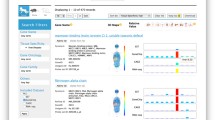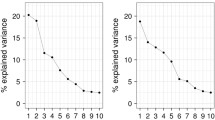Abstract
Recent studies have shown that, in mammals, the highly expressed genes have shorter gene length and their protein products have relatively lower evolutionary rates. However, the global relationship between genes’ expression level and their features such as tissue-specificity, function and protein subcellular localization has not been investigated extensively, especially in mammalian. In order to solve it, we analysed 8,570 genes across 46 human tissues. Our results suggest that widely expressed genes have higher mean expression levels than tissue-specific ones and genes encoding zinc-finger proteins have low expression levels similar to that of DNA-binding proteins. In the analysis of protein subcellular localization, it is shown that nuclear and Golgi apparatus proteins have lower mean expression levels than those of mitochondria, endoplasmic reticulum and membrane proteins, while genes encoding cytoplasm and extracellular components display the highest expression levels. When comparing the gene expression levels and the number of expressed genes in different tissues, we found that some tissues have less active genes while single gene encodes relatively more transcripts. Taken together, gene expression levels are clearly correlated with their tissue-specificity, function and protein subcellular localization, and are highly conserved during evolution.



Similar content being viewed by others
References
Nie H, Crooijmans RP, Lammers A, van Schothorst EM, Keijer J, Neerincx PB, Leunissen JA, Megens HJ, Groenen MA (2010) Gene expression in chicken reveals correlation with structural genomic features and conserved patterns of transcription in the terrestrial vertebrates. PLoS One 5(8):e11990
De Ferrari L, Aitken S (2006) Mining housekeeping genes with a Naive Bayes classifier. BMC Genomic 7:277
Eisenberg E, Levanon EY (2003) Human housekeeping genes are compact. Trends Genet 19(7):362–365
Urrutia AO, Hurst LD (2003) The signature of selection mediated by expression on human genes. Genome Res 13(10):2260–2264
Duret L, Mouchiroud D (2000) Determinants of substitution rates in mammalian genes: expression pattern affects selection intensity but not mutation rate. Mol Biol Evol 17(1):68–74
Drawid A, Jansen R, Gerstein M (2000) Genome-wide analysis relating expression level with protein subcellular localization. Trends Genet 16(10):426–430
Tartaglia GG, Vendruscolo M (2009) Correlation between mRNA expression levels and protein aggregation propensities in subcellular localisations. Mol Biosyst 5(12):1873–1876
Su AI, Cooke MP, Ching KA, Hakak Y, Walker JR, Wiltshire T, Orth AP, Vega RG, Sapinoso LM, Moqrich A et al (2002) Large-scale analysis of the human and mouse transcriptomes. Proc Natl Acad Sci USA 99(7):4465–4470
Huminiecki L, Lloyd AT, Wolfe KH (2003) Congruence of tissue expression profiles from gene expression atlas, SAGEmap and TissueInfo databases. BMC Genomics 4(1):31
The Gene Ontology Consortium (2001) Creating the gene ontology resource: design and implementation. Genome Res 11(8):1425–1433
Vander AJ, Sherman JH, Luciano DS (1998) Human physiology: the mechanisms of body function. WCB McGraw-Hill, Boston, MA
Niehrs C, Pollet N (1999) Synexpression groups in eukaryotes. Nature 402(6761):483–487
Venter JC, Adams MD, Myers EW, Li PW, Mural RJ, Sutton GG, Smith HO, Yandell M, Evans CA, Holt RA et al (2001) The sequence of the human genome. Science 291(5507):1304–1351
Lander ES, Linton LM, Birren B, Nusbaum C, Zody MC, Baldwin J, Devon K, Dewar K, Doyle M, FitzHugh W et al (2001) Initial sequencing and analysis of the human genome. Nature 409(6822):860–921
Liao BY, Zhang J (2006) Low rates of expression profile divergence in highly expressed genes and tissue-specific genes during mammalian evolution. Mol Biol Evol 23(6):1119–1128
Akashi H (2001) Gene expression and molecular evolution. Curr Opin Genet Dev 11(6):660–666
Schena M (2003) Microarray analysis. Wiley, New York
Lehner B, Fraser AG (2004) Protein domains enriched in mammalian tissue-specific or widely expressed genes. Trends Genet 20(10):468–472
Hartwig A (2001) Zinc finger proteins as potential targets for toxic metal ions: differential effects on structure and function. Antioxid Redox Signal 3(4):625–634
Gout JF, Kahn D, Duret L (2010) Paramecium Post-Genomics Consortium: the relationship among gene expression, the evolution of gene dosage, and the rate of protein evolution 6(5):e1000944 (Erratum in: PLoS Genet 6(6): doi:10.1371/annotation/c55d5089-ba2f-449d-8696-2bc8395978db)
Pal C, Papp B, Hurst LD (2001) Highly expressed genes in yeast evolve slowly. Genetics 158(2):927–931
Krylov DM, Wolf YI, Rogozin IB, Koonin EV (2003) Gene loss, protein sequence divergence, gene dispensability, expression level, and interactivity are correlated in eukaryotic evolution. Genome Res 13(10):2229–2235
Acknowledgments
This work was supported by the National 973 program of China (2004CB518605), the National 863 project of China (2006AA020501), the National Key Sci-Tech Special Project of China (2008ZX10002-020), the Project of the Shanghai Municipal Science and Technology Commission (03dz14086) and the National Natural Science foundation of China (30024001, 30771188).
Author information
Authors and Affiliations
Corresponding authors
Electronic supplementary material
The following additional data include three tables. (1) Key statistics of the box-plot representation of the distribution of expression level of ranked genes which have been visualized in Fig. 1a. (2) Detailed information of highly expressed tissue-specific genes (ranks 1–4); (3) Gene number and total AD in tissues which have been illustrated in Fig. 3a.
Rights and permissions
About this article
Cite this article
Li, Q., Liu, X., He, Q. et al. Systematic analysis of gene expression level with tissue-specificity, function and protein subcellular localization in human transcriptome. Mol Biol Rep 38, 2597–2602 (2011). https://doi.org/10.1007/s11033-010-0400-z
Received:
Accepted:
Published:
Issue Date:
DOI: https://doi.org/10.1007/s11033-010-0400-z




